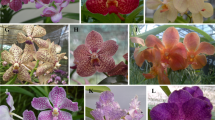Abstract
Growth and flowering responses of Anigozanthos hybrids, ‘Regal Claw’ and A. manglesii × A. flavidus, were investigated starting from in vitro propagated propagules. Flowering of 9-week old ‘Regal Claw’ was less than 50% from the main fan (MF) when plants received 21.0°C during day and 13.0°C at night (21.0/13.0°C, day/night). Flowering of 20-week old ‘Regal Claw’ and A. manglesii × A. flavidus hybrids either from the MF or the lateral fans (LF) was accelerated when plants received 21.0/13.0°C regardless of photoperiod treatment. Flowering from the lateral fans was accelerated when plants received 8 hours of long day photoperiod (LD) treatment as a day-extension provided from incandescent light bulbs at 21.0/15.5°C and 21.0/18.0°C. Fewer than 2.5 total branches per inflorescence were produced from the MF grown at 18.0°C as compared to more than 4.0 total branches produced at 13.0°C. Plants must be 20-week old to flower from both the MF and the LF. The optimum temperature for early flowering and for an increased quality of cut flowers was considered to be 13.0°C, and at this inductive night temperature for flowering, ‘Regal Claw’ and A. manglesii × A. flavidus are considered as a day neutral, while at 15.5°C and 18.0°C, they are considered as a quantitative long day (LD) plant.
Access this article
We’re sorry, something doesn't seem to be working properly.
Please try refreshing the page. If that doesn't work, please contact support so we can address the problem.
Similar content being viewed by others
Literature Cited
Baldwin, R. 1991. Kangaroo paws hop into California gardens: The cultivation of Anigozanthos in California. Austral. Plant Symp. Univ. of California, Santa Cruz. http://www.smgrowers.com/info/anigozanthosTalk.asp.
Ben-Tal, Y. and R.W. King. 1997. Environmenal factors involved in colouration of flowers of kangaroo paw. Scientia Hort. 72:35–48.
Ellyard, R.K. 1978. In vitro propagation of Anigozanthos manglesii, Anigozanthos flavidus, and Macropidia fuliginosa. HortScience 13:662–663.
Grieve, B.J. and N. Marchant. 1963. The kangaroo paws of W. A. Australian Plants 2:107–115.
Growns, D. 2005. Cultivation of kangaroo paws. Farmnote No. 22/96. Dept. of Agriculture, Western Australia. http://www.agric.wa.gov.au/objtwr/imported_assets/content/hort/flor/cp/f02296.pdf.
Hagiladi, A. 1983. Influence of temperature and daylength on growth and flower yield of Anigozanthos manglesii D. Don (Haemodoraceae). HortScience 18:369–371.
Halevy, A.H. and D. Weiss. 1991. Flowering control of recently introduced F1-hybrid cultivars of Godetia. Sci. Hort. 46:295–299.
Hughes, S.M. 1983. Aspects of cultivation of Anigozanthos species as ornamental plants. Dipl. Hort. Sci., Thesis, University of Sydney.
Motum, G.H. and P.B. Goodwin. 1987a. Floral initiation in kangaroo paw (Anigozanthos spp.): A scanning electron microscope study. Scientia Hort. 32:115–122.
Motum, G.H. and P.B. Goodwin. 1987b. The control of flowering in kangaroo paw (Anigozanthos spp.). Sci. Hort. 32:123–133.
Roh, S.M. and H.F. Wilkins. 1977. The physiology of dormancy and maturity of Lilium longiflorum Thunb. cv. Nellie White bulb. IV. Dormancy and maturity — Translocation in the double nose bulb. J. Kor. Soc. Hort. Sci. 18:194–202.
Statistical Analysis System (SAS). 2002. SAS proprietary software version 9.00. SAS Institute, Inc., Cary, NC, USA.
van der Krogt, T.M. 1977. Involvement of the temperature on the production of Anigozanthos flower, Annual floriculture research 1977. Research Station for Floriculture, Aalsmeer, Netherlands p. 20–21. (in Dutch)
van der Krogt, T.M. 1978. Involvement of the daylength on the flower initiation of Anigozanthos, Annual floriculture research 1978. Research Station for Floriculture, Aalsmeer, Netherlands p. 28–29. (in Dutch)
van der Krogt, T.M. and C. Noordegraaf. 1976. Involvement of the temperature in the flower production, Annual floriculture research 1976. Research Station for Floriculture, Aalsmeer, Netherlands p. 16. (in Dutch)
Wilkins, H.F. 1985. Anigozanthos, p. 468–70. In: A.A. Halevy (ed.). Handbook of Flowering Vol. I. CRC Press, Boca Raton, FL, USA.
Worrall, R. 1995. Breeding of dwarf kangaroo paw (Anigozanthos) for use as flowering pot plants. Acta Hort. 397:189–196.
Author information
Authors and Affiliations
Corresponding author
Rights and permissions
About this article
Cite this article
Lee, A.K., Roh, M.S. & Suh, J.K. Growth and flowering responses of Anigozanthos hybrids influenced by plant age, temperature, and photoperiod treatments. Hortic. Environ. Biotechnol. 54, 457–464 (2013). https://doi.org/10.1007/s13580-013-0104-0
Received:
Revised:
Accepted:
Published:
Issue Date:
DOI: https://doi.org/10.1007/s13580-013-0104-0




